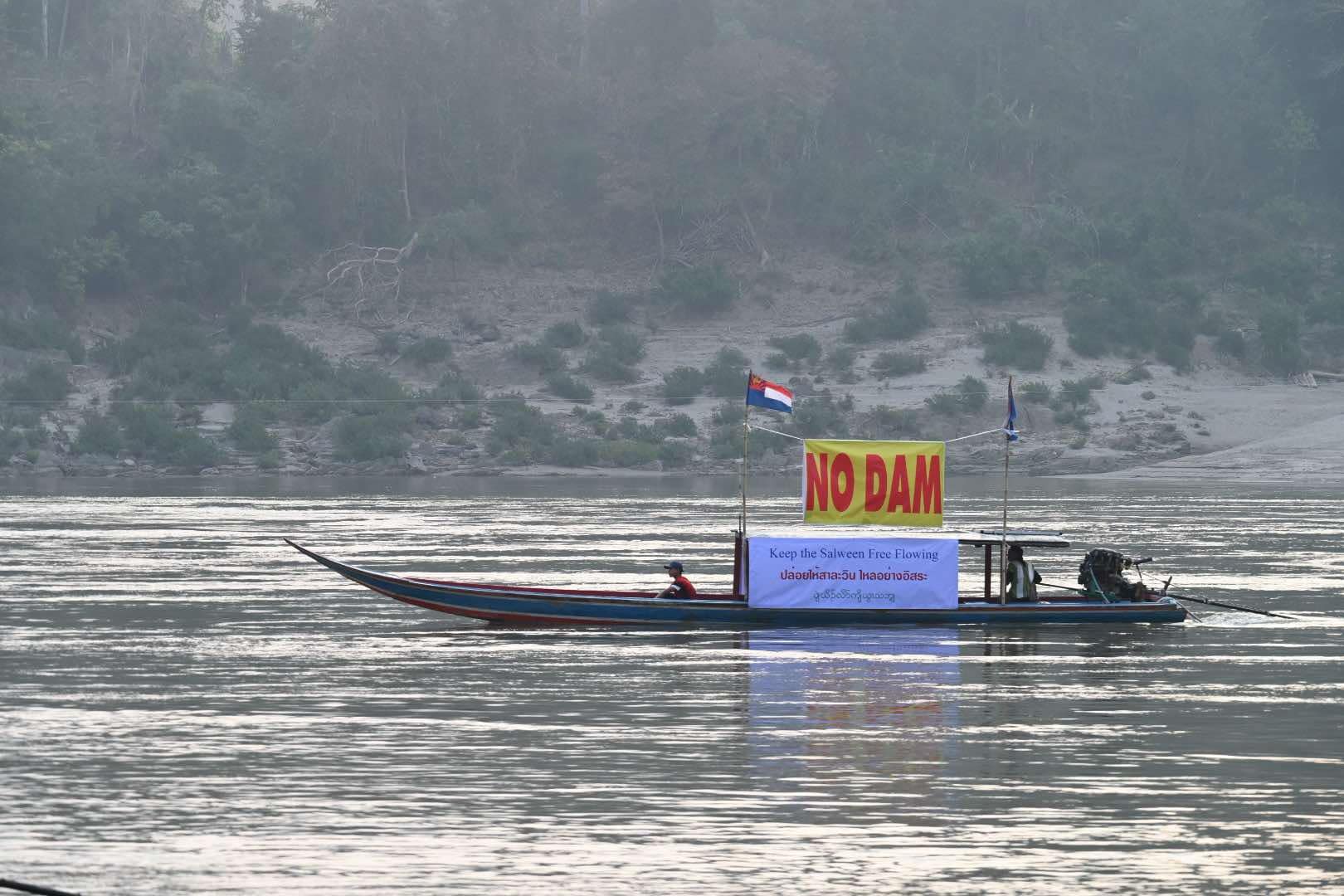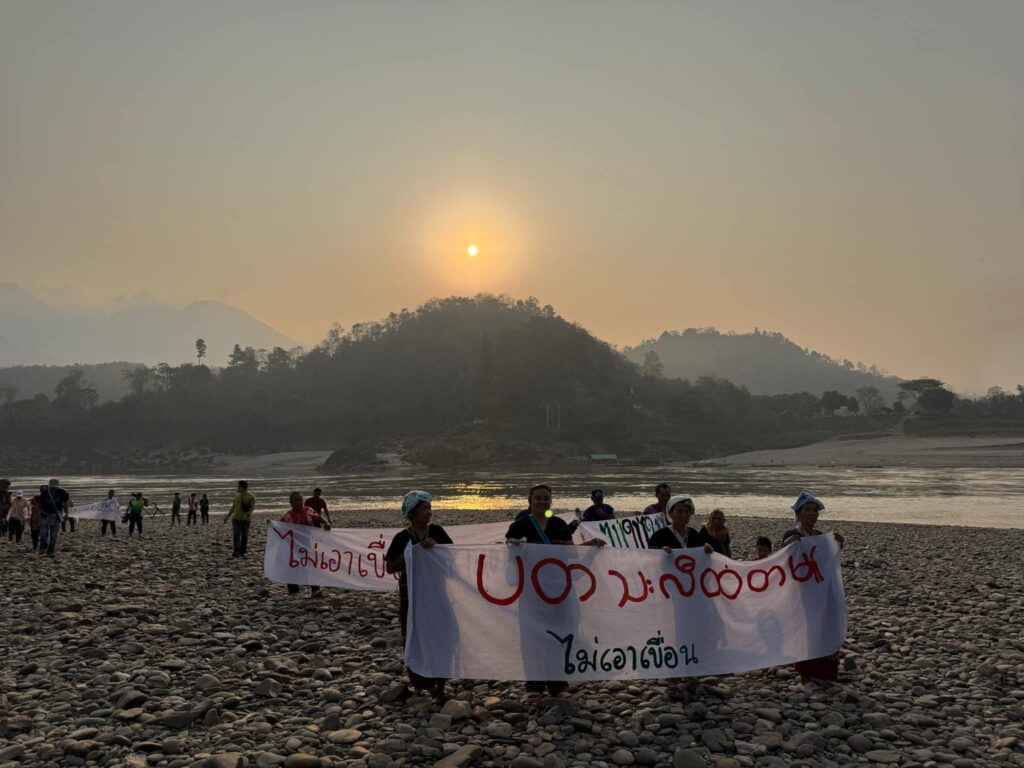Sustainable riverine development advocates warn that the river is still at risk of unsound development of major dams as long as the false demand of electricity is created following the false policy of concerned governments
Thai residents living along the Salween River in the Sob Moei area, Mae Hong Song province, and Karen residents living on the opposite side joined one another in the activities organised on the occasion of the International Day of Action for the Rivers yesterday alongside other residents worldwide.
The day, formally known as the International Day of Action Against Dams and For Rivers, Water and Life, was adopted by the participants of the first International Meeting of People Affected by Dams, in March of 1997 in Curitiba, Brazil. Representatives from 20 countries decided that the International Day of Action would take place on March 14, which was Brazil’s Day of Action Against Large Dams.
The main aim on this International Day is to raise our voices in unison against destructive water development projects, reclaim the health of our watersheds, and demand the equitable and sustainable management of rivers worldwide, according to International Rivers, one of the world’s leading sustainable river development advocacy organisations.
This year, the theme is set as Our Rivers, Our Future, to shine a spotlight on the role of rivers in supporting the planet’s health and all life on Earth. Over 120 events and activities were held across the continents, including those at the Salween. (Check them out @Day of Action for Rivers 2025)
As reported by Transborder News, candles were lit at a sandy beach in the area by the participants who prayed to protect the river. Some boats were set out in the river to campaign against dams along with a march by the participants who held banners with various messages such as “No Dams for Life”, “Salween Basin of Peace”, and others. It’s estimated that more than 300 residents joined in yesterday’s activities.
Karen villagers also sang the Karen national anthem, which is about a healthy land and that people must protect it until they die. This year marks the first time in nearly 30 years that the Salween’s riverside has been free from Burmese military bases. The soldiers of the Karen National Union (KNU) have pushed all Burmese military bases out of the Salween River, Transborder News reported.
Mrs. Bue Mue Por, a representative of the Salween Peace Park, said that people on both sides came together in love and unity and wished for the world to see who they are. They hope that outsiders will respect their community’s values. There is still “a desire” to snatch the resources from the villagers, she said, adding this will have a wide range of impacts on the Karen community, so they must work together to protect it.
“It is not too late for the villagers to join together to take care of the river. We don’t protect it just for today, but we want a sustainable solution within our generation so that our children and grandchildren will have fish and wild animals. We fight for our future, “ said Mrs. Bue Mue Por.
Mr. Yawa Paew Moo, head of forestry in Mue Tho Province, the Karen State, added that Karen villagers join in opposing dams because they would destroy the rivers and cause them to lose their ancestral land. Therefore, everyone has come together to show their stance not to allow dams to be built in the Karen’s land.



l The activities held by the Salween residents to mark an International Day of Action for Rivers. Credit: Pianporn Deetes/ IR
Ms. Pianporn Deetes, the IR’s regional campaign director on issues related to energy, water and environmental justice and community resource rights in SE Asia, said that 17 years ago the villagers ever came together to show their opposition against some dam construction projects that the Electricity Generating Authority of Thailand (Egat) was pushing forward, prompting them to be delayed. Otherwise, this area would be turned into a reservoir, and the Salween River would no longer be free-flowing. (At least seven dams were planned on the river section, including Hat Gyi.)
Mr. Hannarong Yaowalert, an advisor to the Thai Water Partnership said if the dams are allowed to be built in this area, it would be hard for any one to to come to help take care of the villagers like in many areas in Thailand because it’s an international river, which does not fall under any country’s sole sovereignty.
“Building dams on the Salween River carries only one implication, which is to produce electricity. But dams are not the only option for electricity production. Other options exist, and any governments that wish for electricity from the Salween should not claim as such,” Mr. Hannarong said.
Mr. Niwat Roikaew or Kru Tee, Chairman of the Raksa Chiang Khong Group in Chiang Rai Province, who has been campaigning against the dams on the Mekong River, said that the Mekong and Salween rivers are brothers and sisters, but they are devalued to become only the source of hydroelectric power production. The Mekong River has been deteriorated time and again. If it were a person, she would have died already,” said Mr. Niwat.
“Don’t allow anyone to build a dam on the Salween River. You must keep fighting. Even though the Mekong has been severely damaged, we still continue our fight. As this generation fights, the next generation must also fight. Try to create a body of knowledge as well as a network to back up your fight. Build up the new generation to carry a torch and fight for your people’s future,” Mr. Niwat said.
Indie • in-depth online news agency
to “bridge the gap” and “connect the dots” with critical and constructive minds on development and environmental policies in Thailand and the Mekong region; to deliver meaningful messages and create the big picture critical to public understanding and decision-making, thus truly being the public’s critical voice


